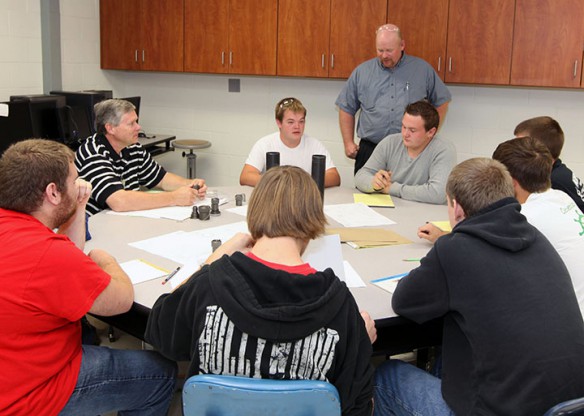
Breckinridge County ATC Computerized Manufacturing and Machining teacher Dean Monarch discussed some of the roles students will be involved in as part of the school’s partnership with the NASA HUNCH program.
Photo by Tim Thornberry, Sept. 18, 2014
By Tim Thornberry
tim.thornberry@education.ky.gov
When Dean Monarch’s students got the opportunity to work on a project with NASA, he wanted to make sure they didn’t take the easy way out.
Machine tool technology students at the Breckinridge County Area Technology Center are helping to create training hardware as part of High School Students United with NASA to Create Hardware (HUNCH).
Monarch, their instructor, said he wanted to make sure his students were challenged.
“I try and push the students every day to learn as much as they can,” Monarch said. “I told the students when we started I picked the hardest project NASA had because I knew they could handle it. They fussed at me when they saw some of the other things we could be building. But if we can do something to showcase our talents, we’re going to do it to the fullest extent we can.”
They are building hardware that will be integrated into NASA’s mockups of the International Space Station (ISS) and used by crews every day in their hands-on environment to train those people who support the ISS.
“Our students are currently in the process of technically starting to make some of the parts. It’s a pretty big learning curve as far as getting everything up and running as far as equipment,” Monarch said.
HUNCH is a collaboration among NASA; the Marshall Space Flight Center in Huntsville, Alabama; the Johnson Space Center in Houston and 67 high school career and tech centers in 24 states that use student skills “to study realistic hardware designs and fabricate simulated hardware based on those designs, according to project manager and International Space Station (ISS) Simulation Engineer Bob Zeek, who visited Breckinridge County ATC earlier in the school year to discuss the mission with students.
In exchange, NASA will receive relatively high-fidelity mockups for use in astronaut crew training and engineering design and prototype development, Zeek said.
Monarch said he has 18 students who are actively involved in the process and who have been working on their project for almost two months.
“We’ve been proving out the processes, and we’ve produced a total of 12 full assemblies, 60 to 72 parts, probably,” he said last month.
He said he thinks his students like the work, even if it hasn’t been easy.
“It’s been quite a challenge for them,” Monarch said. “They are enjoying the work, but they’re getting frustrated occasionally.”
The HUNCH program has grown considerably over the past few years, with more than 1,500 students having come through, some of whom have gone on to work with NASA contractors. There is a postsecondary component to the program as well.
“Ten years ago, we didn’t have any training hardware for our astronaut crew or our ground support personnel, so we came up with the idea to go into the career and tech centers and give those students the opportunity to see what they could do with their skills in machine tool, carpentry, welding and electronics,” Zeek said.
Zeek noted that the real value of HUNCH, which has been noticed by the educational world, has to do with getting students out of their textbooks and into a hands-on environment to create real products.
And Monarch said he’s certain that his students have already seen some benefits from that.
“One of the biggest things is it’s an affirmation for the work they’ve put in in learning through their high school career. It’s been nice for the students to receive some credit on their hard work they’ve put in. I really like that aspect of it,” he said. “And some of my senior students, they’re seeing the benefits of having participated in their job applications.”
He said it’s also a good recruiting tool for the school.
“We do freshman tours and also have middle school students tour the building. There’s a lot of excitement for kids in schools to see something and say, ‘I know some of the people that are working on this.”
The Breckinridge County ATC students will visit the Huntsville space center in April for an awards ceremony and a chance to see their work in use by NASA.
“That is our goal, to have everything done by then,” Monarch said.

Breckinridge County ATC Computerized Manufacturing and Machining teacher Dean Monarch discussed some of the roles students will be involved in as part of the school’s partnership with the NASA HUNCH program.
Photo by Tim Thornberry, Sept. 18, 2014
Zeek said that while academic disciplines like science, technology, engineering and mathematics (STEM) are a focus of technical education, HUNCH adds other skills that magnify what participating students are learning.
“STEM is the buzz word now for our tech centers, but all that goes back to the Common Core environment where you have to have the basics to do math and science,” he said. “When you put the third dimension in there, of building the part and providing the part and taking it from the beginning to the end, it really expands the whole gamut of the education system for these students.”
While the end product is what these students are working toward, Zeek said the experience can also teach students about other aspects of the business, including quality assurance systems; the documentation of the project, including their notes; all the elements of working in industry and getting those students ready to work in industry.
He also pointed out that HUNCH isn’t isolating students to come just to NASA, but preparing them to work in a number of industries. However, several students have been hired by NASA contractors and are working on the HUNCH staff helping to mentor other students.
Dale Winkler, an associate commissioner with the Kentucky Department of Education (KDE), said the HUNCH program falls into place with the Office of Career and Technical Education’s Reach Higher with CTE initiative.
“As CTE has moved into a more visible, viable role with our educational partners, we began this initiative to encourage our students to think beyond some of the traditional but still much-needed roles associated with these types of programs,” Winkler said. “We want our students to imagine using their skills in areas they may not have connected to their tech-ed studies. NASA HUNCH is a perfect example of a high-tech organization recognizing the value in all of our CTE career pathways.”
While Breckinridge County ATC is the only Kentucky school directly affiliated with NASA, Winkler said all of the state’s CTE students can benefit by knowing such a prestigious organization has stepped up to the plate to support technical education in Kentucky.
Monarch said he knows his students will rise to the occasion in creating the machine parts for their project and he wants this to be a student-led effort.
“I don’t want to be the one who leads this; I want these students to take charge of this project and make it their own,” he said.
Monarch’s program has long been noted for its excellence in the machining field. In fact, its placement near the top at the national SkillsUSA competition was what got the attention of NASA.
“They discovered us by looking at the SkillsUSA website and taking note that we had finished in the top 10 at the national event,” he said.
Monarch added that the HUNCH program supports several CTE program areas, including computer-aided drafting, computer electronics, auto body technology, welding technology, electrical technology, carpentry, HVAC technology, graphic design and sewing technology.
Zeek said the participation by these students is not just about making a component for the ISS simulator. It goes beyond that.
“It’s about learning and what it takes to get from the beginning to the end of the project,” he said.
NASA has turned it sights toward many projects, including going into deep space, and will utilize prototypes for ships that will go to Mars. Zeek said the HUNCH program will play a role in getting students involved in projects like that.
“It just makes sense to do this and it gets the students inspired, which is our goal: to inspire the next generation,” he said.
Kentucky Teacher writer Mike Marsee also contributed to this story.
MORE INFO …
Dale Monarch dale.monarch@education.ky.gov




Leave A Comment